How to Solve a Quadratic Equation by Factoring -Answers
The answers are in BOLD below.
NOTE: The transcript from the video is listed below the quiz for your reference.
1. Why can't you solve a quadratic equation simply by using inverse operations to get the variable by itself?
- There are xs and x squareds that need to be separated first.
- You can solve a quadratic equation simply using inverse operations to get the variable by itself.
- There is no way to undo an x squared.
- Mathematicians can't agree on a way to do it.
- You can't solve quadratic equations.
2. What does the Zero Product Property tell us?
- If you get a product of zero, both the factors must have been zero.
- If you get a product of zero, at least one of the factors must have been zero.
- If you get a product of zero, neither of the factors could have been zero.
- There is no way to get a product of zero.
- There are only two ways to get a product of zero.
3.
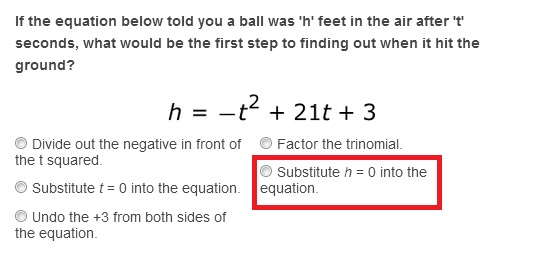
4.
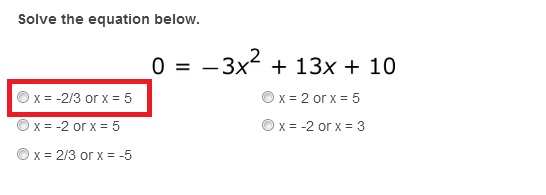
5.
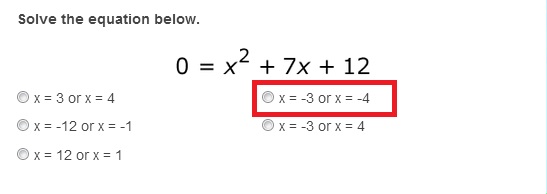
If your favorite video game, 'Furious Fowls,' gave you the quadratic equation for each shot you made, would you be able to solve the equation to make sure every one hit its target? If not, you will after watching this video!
Solve A Quadratic Equation With Factoring
Welcome to level one of 'Furious Fowls,' the game that puts you in control of the birds that are trying to get their eggs back from those pesky pigs. Can you launch your bird at the exact right angle to make sure your bird gets a direct hit? We're about to find out.
The only difference between 'Furious Fowls' and other games out there that are similar is that you only get one shot to make your hit. So it better be worth it! But, because you only get one shot, we will give you a hint to help you out and make sure your first shot is always a direct hit. What kind of a hint am I talking about? Let's check out level one.
So here we go; our bird's all set in our sling shot ready to go, and our pig is waiting very smugly over there, thinking it's safe. But, we want to make sure we get him. I can try to eyeball it by swinging my bird up and down here. Notice that as I swing it in different directions, the mathematical equation in the corner of the screen is changing. It's going to be your job to use that mathematical equation to make sure that your one shot hits its target.
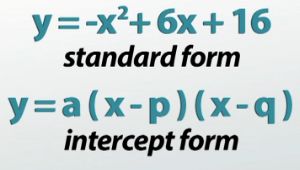 |
Example #1
Let's go ahead and try to line up a shot. Maybe like this; that looks about right. The game has told us that if we fire at this angle, our bird will fly in a path that follows the quadratic equationy = -x^2 + 6x + 16 where y is the height of the bird and x is the distance it has traveled. Since we're trying to hit a pig that's sitting on the ground, we're curious when our bird will hit the ground, which is where y = 0. Substituting this value in gives us this equation. This equation is asking us the question, how far will our bird go before it hits the ground?
We normally solve equations by using inverse operations to get the variable by itself, but in this case, we'd run into some problems with that strategy. Because there are xs but also x^2s in this equation, there isn't just one variable we can get by itself. This means we need a new strategy for solving quadratic equations. While there are a few different ways to do this, the most basic is through factoring. While this way won't always work, it is probably the easiest way to do it, so knowing how to is really helpful. Factoring the quadratic will change it from standard form into intercept form, which will tell us exactly where the parabola crosses the x-axis (where its x intercepts are), or in this problem, where the bird hits the ground.
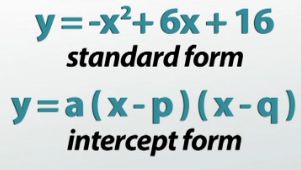 |
To factor a quadratic, it's really nice not having a negative x^2 term, so let's divide that part out first. Pulling a negative from each term leaves us with this equation instead. Now we can begin to look for the two numbers that have a product of -16 and a sum of -6. The reason we're doing that is all about factoring. So if you're struggling with factoring, you should probably go back and check out a previous lesson to get the basics. Finding a pair of numbers that satisfy these two equations will be easiest if we write out the different factors of 16 and look for the pair of them that can add or subtract to -6. Doing that makes it look like 2 and -8 are our winners. We can therefore rewrite our equation as this: (0 = -(x - 8)(x + 2)).
But why did we do that? How has that gotten us any closer to solving this equation for x? I still have two of them; I can't get one of them by themselves. Well, what we now have is a product that equals zero. This allows us to use what is called the zero product property, which says that anytime a product equals zero, at least one of the things we are multiplying must be zero. Another way of saying that is this: the only way to multiply two things and end up with zero is by having one of those two things be zero itself. What this allows us to do is split the equation up and say that either x - 8 orx + 2 is equal to zero. Now that the xs are separated, we can again use inverse operations to solve for them. Undoing -8 and +2 tells us that the two places where our bird will hit the ground are at x = -2 or x = 8.
Well, in our game here that -2 answer might happen if the slingshot broke, but we're more concerned with the answer of 8. And it looks now, if our bird flies out to 8, it will go right over the pig we're trying to hit, so making this shot would be a waste of a bird.
 |
Example #2
But if we slightly adjust it, maybe aiming up a little bit so that our bird flies higher in the air but doesn't go as far, we are told it will now fly the path of this parabola y = -2x^2 + 11x + 21. Let's see if this does what we want it to.
We'll again substitute in y = 0 in order to find out when our bird will hit the ground, and then factor the quadratic to separate the xs and allow us to use the zero product property. We again begin by taking out the negative in order to help us factor, leaving us with this. We then need to find a pair of numbers whose product is -42 (the first term times the last term) and again, whose sum adds up to -11. Writing out the factors of 42 and comparing the pairs of numbers makes it appear that 3 and -14 are our winners. But since we have a 2 in front of our x squared term, we'll need to use the area method to figure out exactly how this all factors. Putting the two values we just found in one diagonal of our box as coefficients on xs, with the 2x^2 and the -21 in the other diagonal, allows us to work our way to the outside and find our factored expression. We do this by finding the greatest common factor in each row and column.
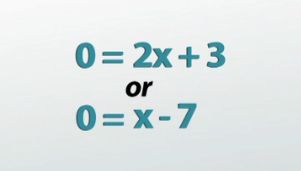 |
In the far left column, both terms have a 2 and anx; in the right column both terms have a 3. In the top row, both terms only share an x; and in the bottom row, both terms only share a -7. This makes the factored form of (2x^2 - 11x - 21) the same as 2x + 3 times x - 7. Again, for more help on factoring, check out the previous video.
Now that we've factored the quadratic, we can use the zero product property to split up the xs and say that either 2x + 3 = 0 or x - 7 = 0. A few quick inverse operations later tells us that our bird will hit the ground at either 7 or -3/2. Our -3/2 answer doesn't concern us too much, but it looks like having our bird land at 7 is exactly what we want. We can fire this bird feeling confident that we'll hit it on our first try and pass level one.
Congratulations! You've just passed level one of 'Furious Fowls!' You can now move onto level two, where things are going to get a little bit harder.
Lesson Summary
Before you do that, though, let's quickly review what you've learned from level one. If you are trying to find when an object launched into the air will hit the ground, you must set the quadratic equation equal to zero and solve it.
Solving quadratic equations with only inverse operations won't work because there are xs and x^2's. What we need a way to break them up first. One way to do this is with factoring and then using the zero product property. This allows you to set up two separate equations that can be solved with inverse operations to get our two separate answers.